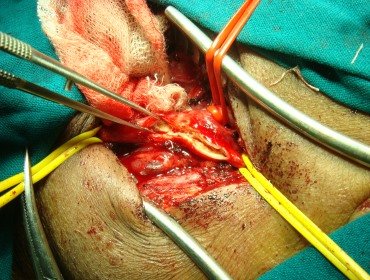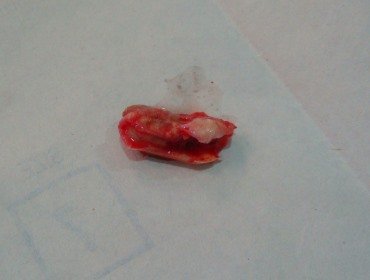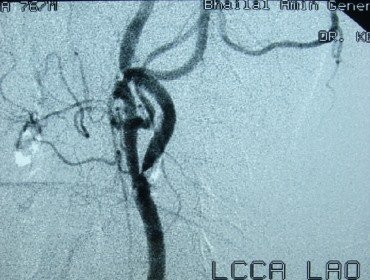Carotid Artery Blockage Treatment
What is Carotid Disease?

Blockage in the Carotid Artery in neck is a common and important cause for development of brain stroke or paralysis, a potentially disabling and often life-threatening condition. The role of vascular specialist in removing this blockage is vital in the prevention of stroke.
The causes or risk factors for blockage in Carotid Artery are similar to those for heart blockage or leg artery blockage.
What are the symptoms of blocked Carotid Arteries?

Weakness or numbness on one side (leg, arm or face), slurred speech or visual disturbances are the usual visible symptoms of mini-stroke. Even if these events last for a few minutes or hours, they could be warning signs of carotid blockage and an impending stroke.
They need to be evaluated by a Carotid Doppler test which is a simple non-invasive sonography of neck. A confirmatory Angiography or CT Angiography is done if intervention is planned.
Patients with high blood pressure, diabetes and cholesterol or past heart problems should also undergo a baseline Carotid Doppler test.
What are the treatment options?

- Minor blockages (less than 50%) are treated by blood thinner and cholesterol controlling medicines. If blockage is more than 50 or 60 %, then surgery or angioplasty with stenting is recommended.
- Carotid Endarterectomy is a special surgical operation for removal of the Carotid Artery blockage. We routinely perform this procedure under a locoregional anesthesia so that intra-operative neurologic monitoring is easy. The artery is opened and the plaque is carefully removed. During this operation, we use a shunt to maintain blood flow to the brain. The artery is then repaired using a vein or graft patch to prevent narrowing.
- The other treatment option we offer is Carotid Angioplasty with stenting under protection device. These protection devices prevent small plaque particles to dislodge to the brain during stenting and thus the complications of this procedure is reduced to less than 3%. It is mainly performed for high-risk patients or those with high carotid bifurcation.
Can a major stroke be prevented?

If the blockage is detected and treated successfully in time, the further chances of a major stroke are minimised.
Can this procedure be utilised to treat stroke?

Once a patient develops stroke, some permanent damages would already have occurred in the brain. So this treatment will not cause significant improvement in the problems. This is why it is very essential to treat carotid blockage before a major stroke strikes you!
Frequently asked questions

Like the arteries that supply blood to the heart, the carotid arteries can also develop atheroscerosis in other word “hardening of the Arteries” on the inside of the vessels. Carotid artery disease is caused by a buildup of plaques in neck arteries that deliver blood to your brain. Plaques are clumps of cholesterol, calcium, fibrous tissue and other cellular debris that gather at microscopic injury sites within the artery. This process is called atherosclerosis.
Atherosclerosis is the most common cause of carotid artery disease. This thickening narrows the arteries and can decrease blood flow or completely block the flow of blood to the brain.
Yes, Carotid Artery disease causes about 10 % to 20 % of strokes. A stroke is a medical emergency that can leave you with permanent brain damage and muscle weakness ( paralysis of one or more limbs). In severe cases, a stoke can be fatal. Carotid Artery stenosis can be dangerous if it’s not diagnosed and treated quickly.
Carotid artery disease can cause stroke and lead to other problems. However, it usually isn’t fatal by itself. The annual stroke risk increases as the degree of blockage increases to more than 70%.
In majority cases you may not have any symptoms of carotid artery disease. Plaque builds up in the carotid arteries over time with no warning signs until you have a Transient Ischemic Attack ( TIA) or a stroke.
Signs of a stroke may include:
- Sudden loss of vision, blurred vision, or difficulty in seeing out of one or both eyes
- Weakness, tingling, or numbness on one side of the face, one side of the body, or in one arm or leg
- Sudden difficulty in walking, loss of balance, lack of coordination
- Sudden dizziness and/or confusion
- Difficulty in speech / speaking
- Confusion
- Problems with memory
The risk factors for carotid artery disease are similar to those for other types of heart disease. People having following mentioned abnormalities or problem are at higher risk for carotid artery disease: Higher age, Tobacco consumption, Smoking, Hypertension (high blood pressure) the most important treatable risk factor for stroke, Abnormal lipid profile or high cholesterol, Insulin resistance, Diabetes, Obesity, Sedentary lifestyle, Family history of atherosclerosis, either coronary artery disease or carotid artery disease.
Making some changes to your diet and exercise habits can help treat and prevent carotid artery disease. These healthy life style changes can also help you maintain a healthy weight and manage high blood pressure and cholesterol.
- Eat a healthy, low-fat diet.
- Eat plenty of fruits and vegetables. Fresh or frozen are better choices than canned, which may have added salt or sugar.
- Choose high-fiber foods, such as whole-grain breads, pastas, cereals, and crackers.
- Eat lean meats ( for non vegetarian people) They can eat fish twice a week.
- Cut back on saturated fat, cholesterol, and added salt and sugar.
- Be more physically active
To effectively treat carotid artery disease, your doctor will recommend the following:
- Lifestyle changes to slow the progression of atherosclerosis
- Medication to control blood pressure or lower cholesterol.
If blockage is severe ( more than 70%) or if you have higher risk of recurrent stroke, your doctor may recommend removing the blockage from the artery and options for the same are as below:
Carotid endarterectomy: The most common surgical treatment for severe carotid artery disease. After making an incision along the front of your neck, the surgeon opens the affected carotid artery and removes the plaques. The artery is repaired with stitches and a synthetic graft patch.
Carotid Angioplasty and Stenting: This endovascular procedure is recommended if the blockage is too difficult to reach with carotid endarterectomy or you have other health conditions that make surgery too risky. You are given local anesthesia and a tiny balloon is threaded by catheter to the area of the clog. The balloon is inflated to widen the artery, and a small wire mesh coil (stent) is inserted to keep the artery from narrowing again.
For acute stroke, it is best to consult a neuro interventional department. Although traditionally, most strokes are treated by medical management by neurologists, a sudden massive strike can be reversed by reaching to a Neurointervention department and clots can be removed within 4 to 6 hours with good results.
For diagnosed carotid artery disease, a Vascular & Endovascular Surgeon would be a better choice to decide whether carotid endarterectomy or angioplasty is suitable for your blockage and do the needful.
Gallery


Carotid Endarterectomy

Excised Carotid Plaque

PTFE patch

Angiography shows Cartoid Stenosis

Carotid Angioplasty Filter

Carotid body tumor



